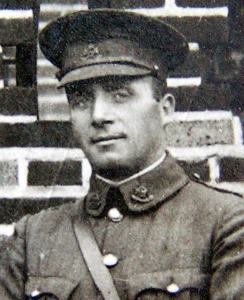We spent the remainder of Christmas Week quietly and about New Year’s Day 1917 an issue of a new Rifle Grenade arrived in the trenches. The grenade which had been given the name “Newton Pippin” after the apple was very vicious and had a range of 400 yards and because there was a danger when being fired from a rifle of a premature detonation it was considered safer to attach a cord to the rifle trigger and pull it from behind a sandbag barricade.
 Henry Newton (1880-1959) designer of the “Newton Pippin” rifle grenade and a Captain in the 5th Battalion Sherwood Foresters.
Henry Newton (1880-1959) designer of the “Newton Pippin” rifle grenade and a Captain in the 5th Battalion Sherwood Foresters.
They were new to this part of the front and therefore treated with suspicion and care. The Commanding Officer gave me instructions to operate the grenade against the German dugouts and emplacements behind the German front line so for 3 or 4 days we prepared a number of emplacements in the front line or just behind. It was a reasonable understanding on the part of the inhabitants of the front line trenches that if the Sector was reasonably quiet it should be left that way. They did not welcome any introduction of new weapons because as soon as something new was tried out the Germans retaliated with all sorts of flak, trench mortars, minewerfers, shrapnel and high explosive shells which of course soon made life very unhealthy indeed.
On the 3rd January we sallied forth from the support line about 30 strong carrying our stock of Newton Pippins in cases. We arrived at our prepared emplacements and soon the word went round that we intended to use them against the enemy so extra steps were taken to get some shelter from the resultant retaliation. The first grenade was pushed down the muzzle of the rifle, the range checked by means of lowering or raising the muzzle. I attached the cord to the trigger took the end round the protective barricade and making sure that my men were all well out of the way pulled the cord.
Crack went the cartridge and away soared the grenade. We followed the course and the explosion in the German rear. It was marvellous and very effective. This was just what we wanted. I loaded – again the same result. The Germans who I suppose were considering the new weapon were up to now fairly quiet but I knew from experience that they were considering the range factor. How far and from which direction had the grenade come? I know also that one of the enemy had been detailed to watch and listen for the crack of the cartridge or the twang of a catapult.
I loaded again, pulled the cord and away went the grenade – the subsequent explosion amongst the German dugouts, then about a couple of minutes afterwards I heard the unmistakable thump in the German line of trench mortar. Down it came just behind us, then another thump and another crack, one on our front line. They were feeling for our position but they had not got the range. I fired two more mortars. It was time to pack up and get back to safety of our dugout. It was very unfair of us to create this unhealthy disturbance in the front line but the job had to be done however unpleasant.
Next day we repeated the dose and a few senior officers came to observe the result of this remarkable weapon. The retaliation this time was very severe and of course the plea from our front line was to get out and leave them in peace.
[2305 Pte Frank Longson]
Despite the retaliation of the German artillery no men of the 139th Brigade were killed during these few days.
